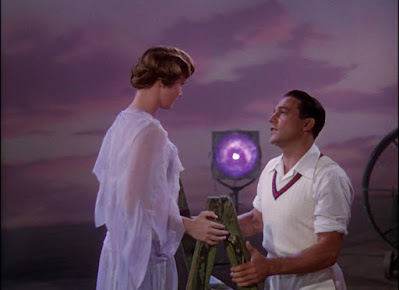Fred and Ginger in Technicolor: The Barkleys of Broadway (1949)
Sadly, by this point in her career, Judy was already struggling with addiction and her mental health was too unstable for her to work regularly. After a few rehearsals for the Barkleys, she was forced to drop out. The studio scrambled to find a replacement who could act, sing, and dance alongside Fred Astaire, and was reminded of a telegram they'd gotten from Ginger Rogers about how much she'd *loved* Easter Parade and just might be available if something similar popped up (wink wink nudge nudge). Ginger was hired as Judy's replacement and quickly began her dance training after a ten-year break from musicals.
The movie's plot was incredibly similar to Fred and Ginger's actual lives - it followed two Broadway stars, Dinah and Josh Barkley, who nearly break up when Dinah decides to go into dramatic acting and Josh wants to keep making musicals. After Josh realizes how talented Dinah is, he decides to help her succeed, but they eventually figure out they're much better as a team. Sound familiar?
Most film critics (and myself) agree that Ginger was the best choice for this film - not just because of the plot, but because she and Fred had such a long history and were able to really sell the story. They'd faced their difficulties as a team, including Ginger's rise as a dramatic star while Fred struggled to find the same success in the 40s. She fought her whole life against the idea that Fred shaped her career, a conflict that arises between the fictional Barkleys as well. Josh and Dinah are such believable characters because everything they go through in the film, Fred and Ginger had lived.
The Barkleys of Broadway was a big hit with new and nostalgic audiences alike, and even inspired many actors and actresses of the 1950s. It served as the beginning of a new era of MGM musicals that would give Fred Astaire some of his most famous starring roles in Funny Face, Silk Stockings, and the Band Wagon. After the Barkleys, Fred and Ginger made plans to continue working together and release films under a new shared production company. Ginger even bought the rights to a screenplay called Wonderful Evening at Waikiki about a burnt-out Broadway dancer who meets a dance teacher in Hawaii (what I wouldn't give to watch that movie!) but the deal fell through before filming could begin.
Though it was impossible for The Barkleys of Broadway to reach the same heights as Top Hat or Swing Time, it was a reminder of the magic of musicals and screen teams. Ginger even suggested using "They Can't Take That Away From Me" as a dance number, which had only been sung in their 1937 film Shall We Dance. The dances in the Barkleys are lovely simply because they're nostalgic, and also because nobody can fake the natural chemistry Fred and Ginger had. Even after ten years apart, their onscreen connection and comfort with each other as dance partners is obvious and makes what could have been another flashy MGM spectacle something entirely different. The Technicolor doesn't hurt, either.
The Barkleys of Broadway would be the end of Fred and Ginger's on-screen partnership, but it was the perfect send-off. The movie has all the hallmarks of their 1930s classics - an incredible solo for Fred, a novelty number where they can show off their love (and questionable talent) for accents, a heartbreaking romantic duet, and a tap number that's fun to watch because it was so obviously fun to dance. Under the direction of MGM, Fred and Ginger traded their elegant black-and-white for big-screen color, and reminded movie audiences everywhere that there's really nothing like a good musical.









Lovely article, Maeve! I had no idea Fred and Ginger intended to continue working together after Barkleys. Thanks for this elegantly educational read.
ReplyDeleteThank you so much!
Delete